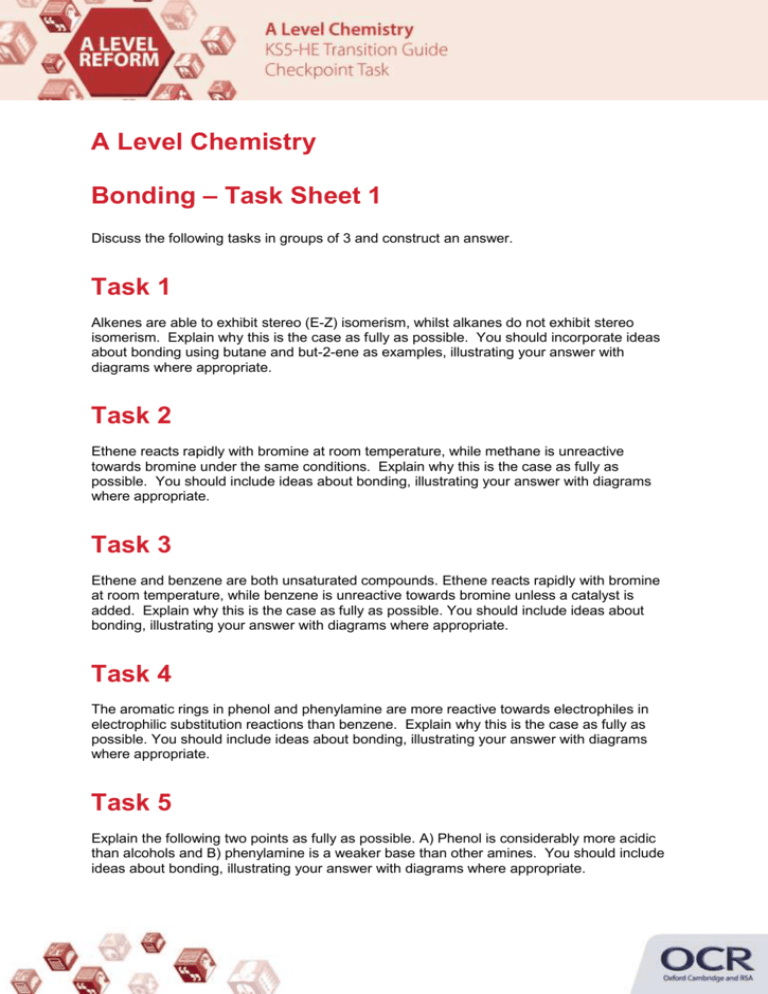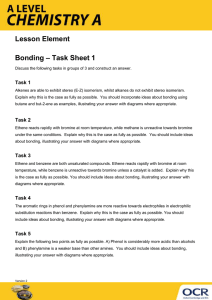Bonding - Checkpoint task
advertisement

A Level Chemistry Bonding – Task Sheet 1 Discuss the following tasks in groups of 3 and construct an answer. Task 1 Alkenes are able to exhibit stereo (E-Z) isomerism, whilst alkanes do not exhibit stereo isomerism. Explain why this is the case as fully as possible. You should incorporate ideas about bonding using butane and but-2-ene as examples, illustrating your answer with diagrams where appropriate. Task 2 Ethene reacts rapidly with bromine at room temperature, while methane is unreactive towards bromine under the same conditions. Explain why this is the case as fully as possible. You should include ideas about bonding, illustrating your answer with diagrams where appropriate. Task 3 Ethene and benzene are both unsaturated compounds. Ethene reacts rapidly with bromine at room temperature, while benzene is unreactive towards bromine unless a catalyst is added. Explain why this is the case as fully as possible. You should include ideas about bonding, illustrating your answer with diagrams where appropriate. Task 4 The aromatic rings in phenol and phenylamine are more reactive towards electrophiles in electrophilic substitution reactions than benzene. Explain why this is the case as fully as possible. You should include ideas about bonding, illustrating your answer with diagrams where appropriate. Task 5 Explain the following two points as fully as possible. A) Phenol is considerably more acidic than alcohols and B) phenylamine is a weaker base than other amines. You should include ideas about bonding, illustrating your answer with diagrams where appropriate. Bonding – Task Sheet 2 Use the checklists below and check your answers. Refine your answers using the checklists. Task 1 Alkenes are able to exhibit stereo (E-Z) isomerism, whilst alkanes do not exhibit geometric stereo. Explain why this is the case as fully as possible. You should incorporate ideas about bonding using butane and but-2-ene as examples, illustrating your answer with diagrams where appropriate. Checklist: Does your answer include the following? - Discussion regarding the presence of single/double bonds in alkanes and alkenes. Discussion of restricted rotation around double bonds. A diagram correctly illustrating the presence of -bonds and -bonds between pairs of carbon atoms in alkanes and alkenes. - An explanation that relates free rotation and restricted rotation around particular bonds between carbon atoms and the nature of the bonding (ie the presence of only or and bonds between carbon atoms). Reference to the energy requirement to break a bond. Diagrams illustrating isomers of the molecules under consideration. - Task 2 Ethene reacts rapidly with bromine at room temperature, while methane is unreactive towards bromine under the same conditions. Explain why this is the case as fully as possible. You should include ideas about bonding, illustrating your answer with diagrams where appropriate. Checklist: Does your answer include the following? - Discussion regarding the presence of single/double bonds in alkanes and alkenes. Discussion of saturation/unsaturation. A diagram correctly illustrating the presence of -bonds and -bonds between pairs of carbon atoms in alkanes and alkenes. Correct use of terms such as electrophilic OR nucleophilic and substitution OR addition in describing the mechanism of the reaction Discussion about the relative availability of and electrons to be donated to another species during a reaction. A full reaction mechanism including curly arrows. An explanation of how/why bromine is able to react with ethene. Task 3 Ethene and benzene are both unsaturated compounds. Ethene reacts rapidly with bromine at room temperature, while benzene is unreactive towards bromine unless a catalyst is added. Explain why this is the case as fully as possible. You should include ideas about bonding, illustrating your answer with diagrams where appropriate. Checklist: Does your answer include the following? - Discussion regarding localised and delocalised electrons, and the availability of pairs of electrons in such systems to be donated to other species. Discussion about the relative stability of benzene and comparable alkenes. A diagram correctly illustrating the bonding (notably -bonding) between carbon atoms in ethene and benzene. Correct use of terms such as electrophilic OR nucleophilic and substitution OR addition in describing the mechanisms of the reactions. Full reaction mechanisms including curly arrows. An explanation of how/why bromine is able to react with ethene but not benzene. Task 4 The aromatic rings in phenol and phenylamine are more reactive towards electrophiles in electrophilic substitution reactions than benzene. Explain why this is the case as fully as possible. You should include ideas about bonding, illustrating your answer with diagrams where appropriate. Checklist: Does your answer include the following? - Discussion about the role of lone pairs on substituent atoms in changing the electron density around the aromatic ring in these compounds relative to benzene, including diagrams to illustrate this. Discussion about the influence of the electron density around aromatics ring on the relative rates of reaction with electrophiles. Task 5 Explain the following two points as fully as possible. A) Phenol is considerably more acidic than alcohols and B) phenylamine is a weaker base than other amines. You should include ideas about bonding, illustrating your answer with diagrams where appropriate. Checklist: Does your answer include the following? - Discussion about the interaction between the system around an aromatic ring and lone pairs/negative charges on substituent atoms, including diagrams to illustrate this. Discussion regarding the stability of the phenoxide ion relative to alkoxides (ie the ions formed by deprotonation of alcohols eg ethoxide from ethanol) (A). Discussion regarding the availability of the lone pair in phenylamine for donation to a proton relative to other amines (B).







